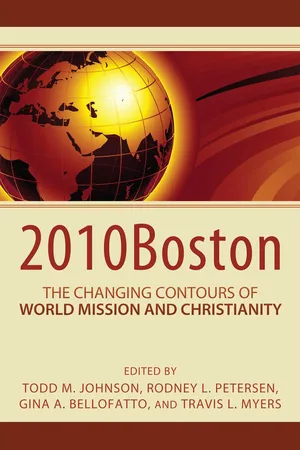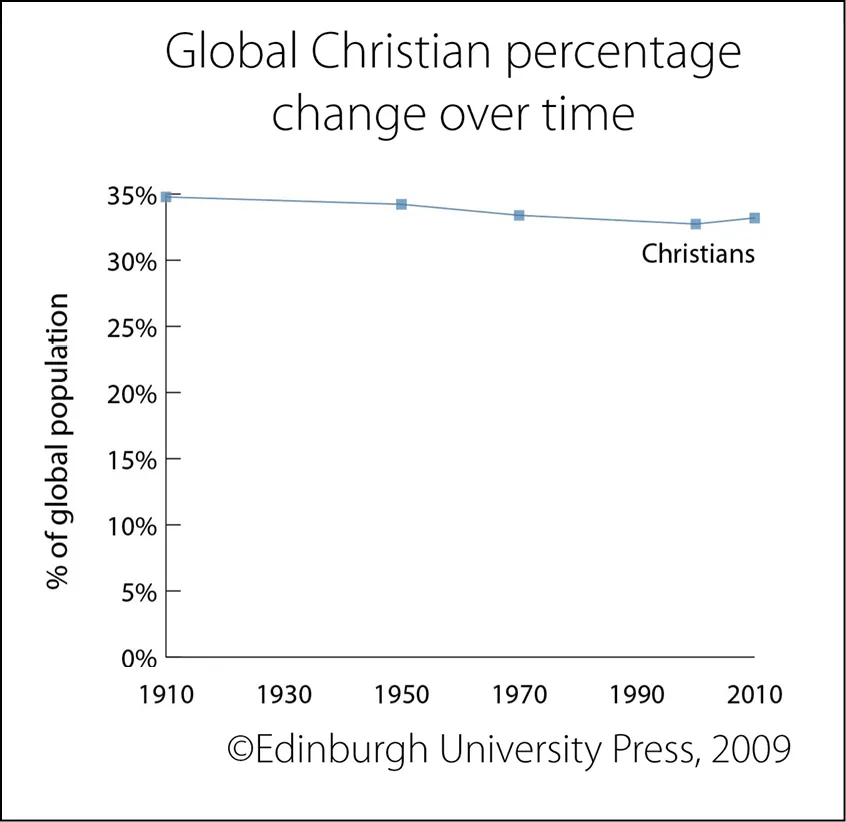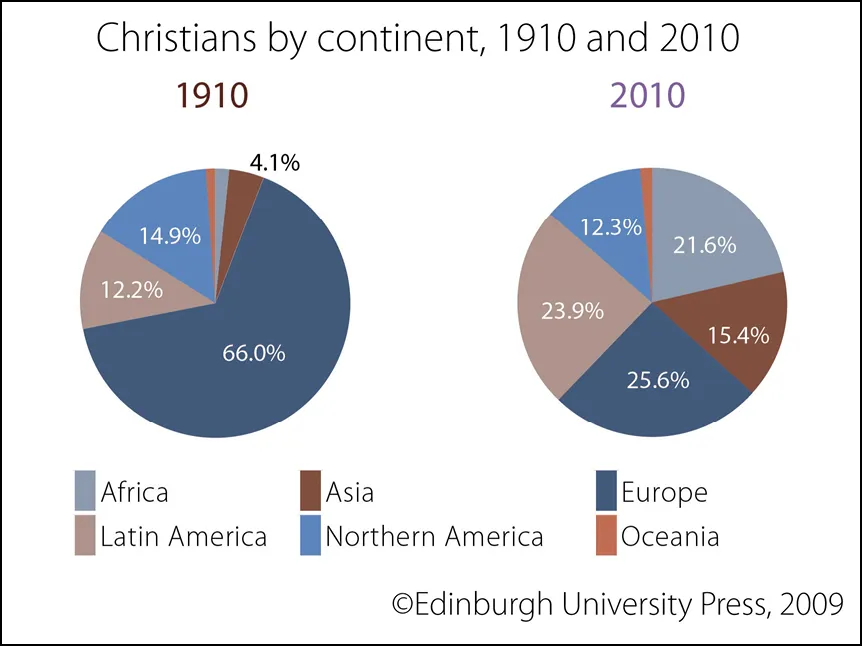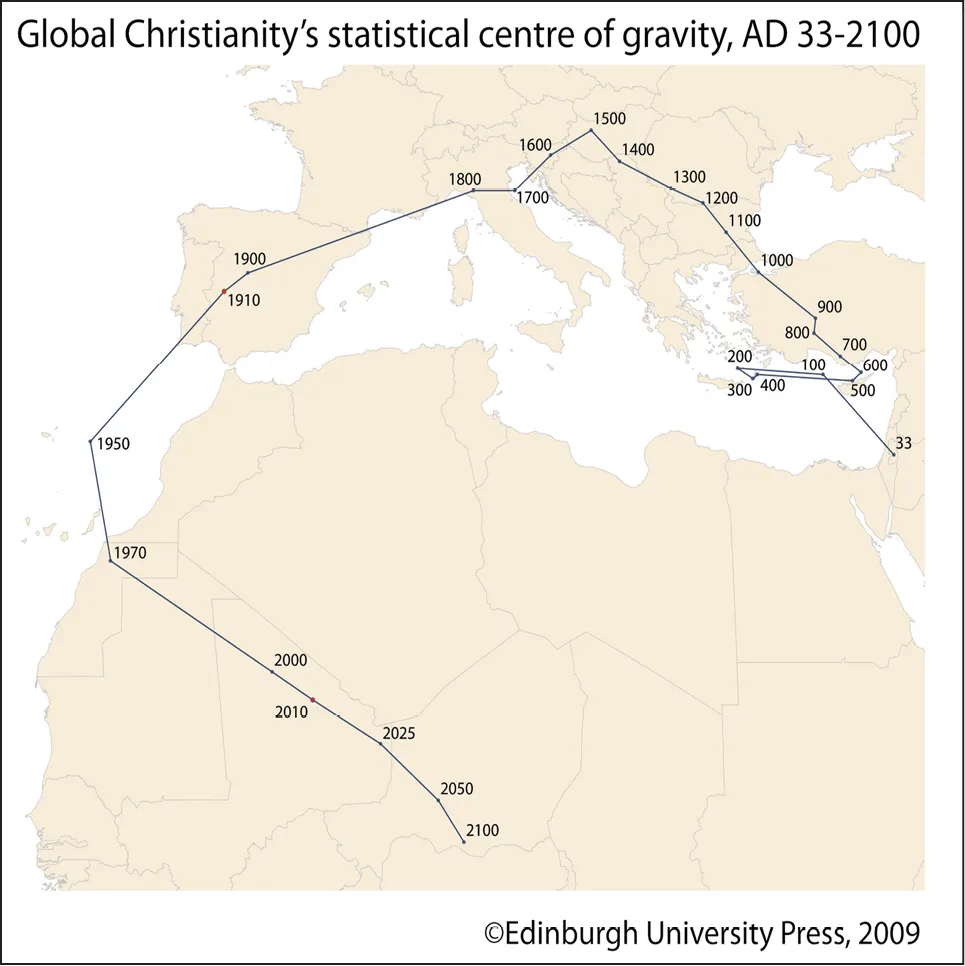![]()
Part I
The World Christian Movement
![]()
1
The Demographics of World Mission and Christianity, 1910–2010
Todd M. Johnson
The Atlas of Global Christianity is the first scholarly atlas to document the shift of Christianity to the global South. It features contextual maps of world issues and major religious traditions, including global coverage of religious freedom and religious diversity. It is the first atlas to map Christian affiliation at the provincial level. It is a unique Christian publication in the sense that it contains ecumenical and global coverage, including all Christian traditions in every country. It partners full-color maps of Christian affiliation in every United Nations region with historical essays on Christianity by sixty-four scholars from every region of the world to highlight the 100-year history of Christianity. Included with the atlas is an interactive presentation assistant on CD of all maps and graphics for classroom use.
To understand the status of global Christianity and world evangelization 100 years after the Edinburgh 1910 World Missionary Conference, one can consider trends both inside of global Christianity and outside of global Christianity.
Trends Inside Global Christianity
One major trend within global Christianity is that Christianity has shifted dramatically to the South. Looking at the graph below (global Christian percentage), one can see that at first glance there has been little change in the status of global Christianity over the past 100 years. For the entire 100-year period, Christians have made up approximately one-third of the world’s population. This masks dramatic changes in the geography of global Christianity—a process of both north-south and east-west movement stretching back to the earliest days of Christianity.
The shift in demographics by continent from 1910 to 2010 most clearly illustrates the shift of Christianity to the global South. While 66 percent of all Christians lived in Europe in 1910, by 2010 only 25.6 percent lived there. By contrast, less than 2 percent of all Christians lived in Africa in 1910, skyrocketing to almost 22 percent by 2010. The global North (defined as Europe and Northern America) contained over 80 percent of all Christians in 1910, falling to under 40 percent by 2010.
The 1910 World Missionary Conference in Edinburgh was placed directly in this Western-dominated picture of global Christianity. As recounted by Ken Ross, “the delegates were, overwhelmingly, British (500) and American (500). Representatives from continental Europe were a small minority (170). Even fewer were the delegates from the ‘younger churches’ of India, China and Japan (17). There were no African participants, nor were there any from Latin America. No delegate was invited from the Roman Catholic or Eastern Orthodox Churches. While the participants were struck by the diversity of participants, from a longer historical perspective it is striking how limited was their range.”
Western influence extended far beyond just the Christian world; Western overconfidence in science and technology was also a major factor throughout the twentieth century. Daniel Jeyaraj notes that “Unprecedented Western discoveries in science, technology, medicine, information communication, dissemination of knowledge, and transportation predicted not only progress and prosperity for all peoples, but also the end of poverty and other miseries. People hoped for a mutual sharing of the earth’s resources. They anticipated equal access to knowledge, opportunities, just global markets and politics.”
Simultaneous to the shift of Christianity to the South was the decline of Christianity in the North. Moonjang Lee notes with irony, “it was through the modern missionary movement that Christianity became a worldwide phenomenon, and in that process Christianity came to acquire the image of a Western religion. The subsequent globalisation of the image of Western Christianity poses a problem for non-Western Christianity. Though we talk about a post-Christian West and a post-Western Christianity, the prevailing forms of Christianity in most parts of the non-Western world are still dominated by Western influences.”
The transition of Christian leadership from North to South has been anything but smooth. Daniel Jeyaraj notes that “When World War II broke out, Western missionaries had to hand over power to the native Christians, whom they had failed to train for leadership tasks, and thus these could not manage the vast landed properties, huge buildings, and money- and time-consuming administrative structures the missionaries left behind. In order to generate money, many church properties were sold. Greed led to court cases, competitions and betrayals.”
One way of illustrating the shift of Christianity is to map the statistical center of gravity of global Christianity over the past 2,000 years (shown below). One can readily see that in the modern period there has been a decisive southern shift. At the time of the 1910 Edinburgh conference the statistical center of global Christianity was near Madrid, Spain. In fact, at that time, over 80 percent of all Christians were European. In 2010 the statistical center was south of Timbuktu in Mali. This 100-year shift is the most dramatic in Christian history.
The southern shift can also be put in context of the entire history of Christianity. Christians of the global South were in the majority for the first 900 years of Christian history. European domination of global Christianity can be seen as a recent phase of world Christianity that has now passed. Since 1981, Southern Christians are, once again, in the majority.
It is obvious to see from the various maps in the atlas that Christianity in 1910 was largely a Western phenomenon—including a strong European Roman Catholic presence in Latin America, where few church leaders were Latin Americans. By mapping the same phenomenon by province one hundred years later, it is clear that the global situation has changed. The most dramatic difference between these two dates is in Africa—less than 10 percent Christian in 1910 but nearly 50 percent Christian in 2010, with sub-Saharan Africa well over 70 percent Christian.
The top ten countries with the most Christians in 1910 and 2010 are presented below, where the southern shift can be quickly perceived. Nine of the top ten countries in 1910 were in the global North, whereas seven of the top ten in 2010 are in the global South. The fastest growth over the past one-hundred years and over the past ten years has all been in the global South (over the past one-hundred years, the top five fastest Christian growth was in Burkina Faso, Chad, Nepal, Burundi, and Rwanda. Over the past ten years, the countries include Afghanistan, Cambodia, Burkina Faso, Mongolia, and Timor). In terms of language, Spanish (the top global l...



